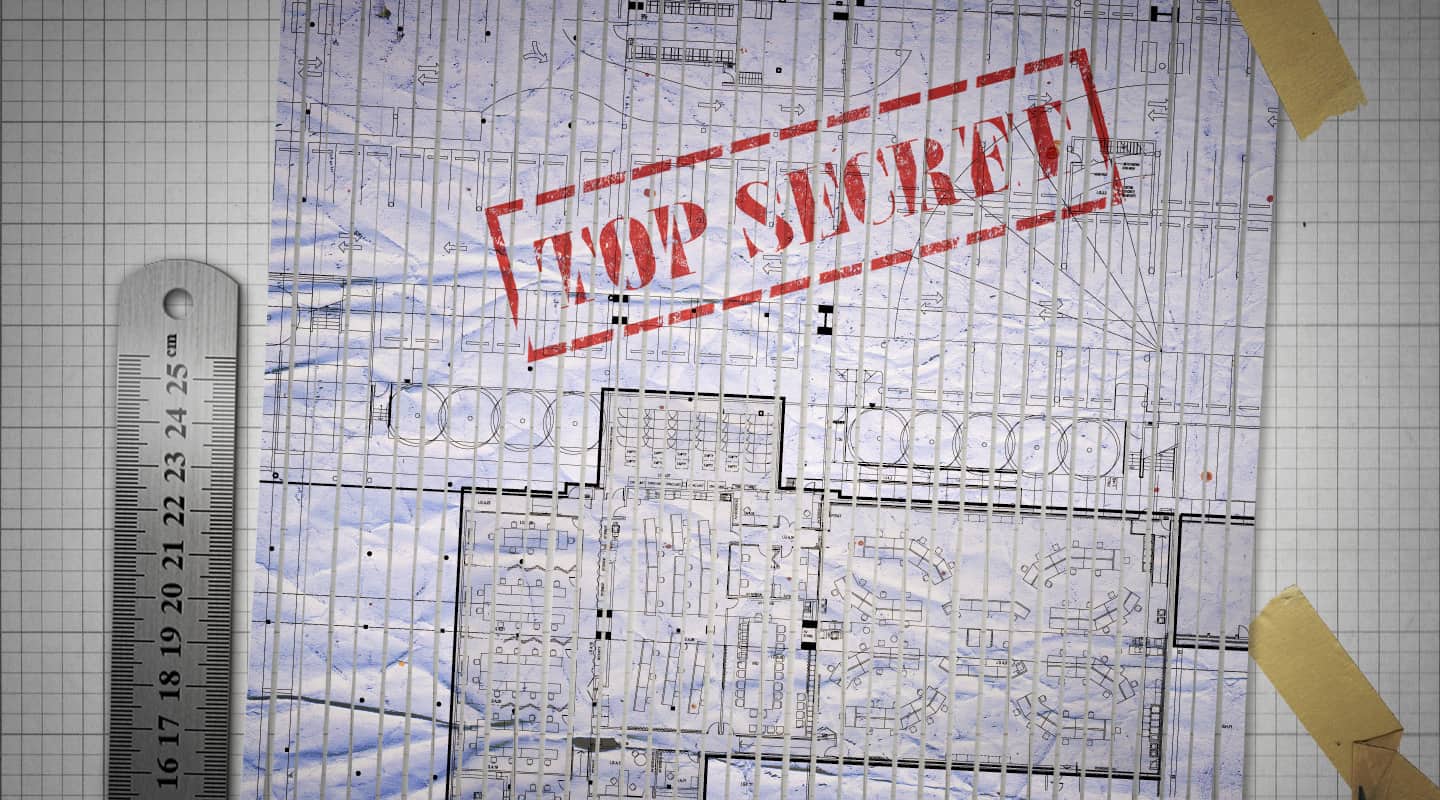
AFP Edmund Barton
Is this a secure line? Details of one of the most significant (and hush-hush) AV jobs of 2011.

Text:/ Andy Ciddor
Commercial confidentiality is part of the AV industry’s stock-in-trade. Of course, we will keep even the very existence of a project, much less its specification, completely under wraps until the job is complete and the client is ready to let us boast about it to our friends, colleagues and prospective clients. Sometimes we even take on a job because the prestige of having done it will enhance our reputation in some way. And then there are the projects that we’re proud of but not allowed to even mention, sometimes it’s for commercial reasons (like the three letter bank that’s sure the entire banking industry will collapse if anyone ever finds out about the technology on the CEO’s desk), and sometimes it’s for ‘public safety’ or ‘national security’.
There’s one very big building complex out in the wilds of Bungendore (near Canberra) that simply doesn’t exist. It includes some very interesting AV projects on a substantial scale, and while some AV readers worked on this project, and have the business records to prove it, they can never admit to it. The project of course was the
and while we Australians can’t admit its existence you can see satellite images of it on Google Maps (-35.344167,149.375556) and it has a its own entry in Wikipedia entry under Headquarters Joint Operations Command (Australia) (which proves beyond doubt that it doesn’t exist, because everything in Wikipedia is wildly inaccurate).
MUM’S THE WORD
A similar veil of secrecy hangs over the headquarters facility of the Australian Federal Police in the Edmund Barton Building in the Canberra suburb of Barton. Despite the dubious honour of having an entry in Wikipedia, we do actually have an Australian Federal Police Force. I know this because I see them all the time at Hobart airport, preventing terrorist attacks and riots; thankfully they have a 100% success rate so far.
Constructed for use as Commonwealth government offices in the early ’70s, the Edmund Barton Building did exist and even has a Commonwealth National Heritage Listing for its clever design by Australian architect Harry Seidler. Regular sightings by local residents indicate that the building is still there, but since its major refurb (prior to the AFP relocating there to consolidate offices that had previously been distributed around Canberra in five other sites), its very existence is now being called into question. Consequently we aren’t able to include any photos of the finished project in this article. As far as we’ve been able to find out, there is a major risk of crime breaking out all over the country if you were to see photos of the actual commercial-off-the-shelf AV equipment installed in the project.
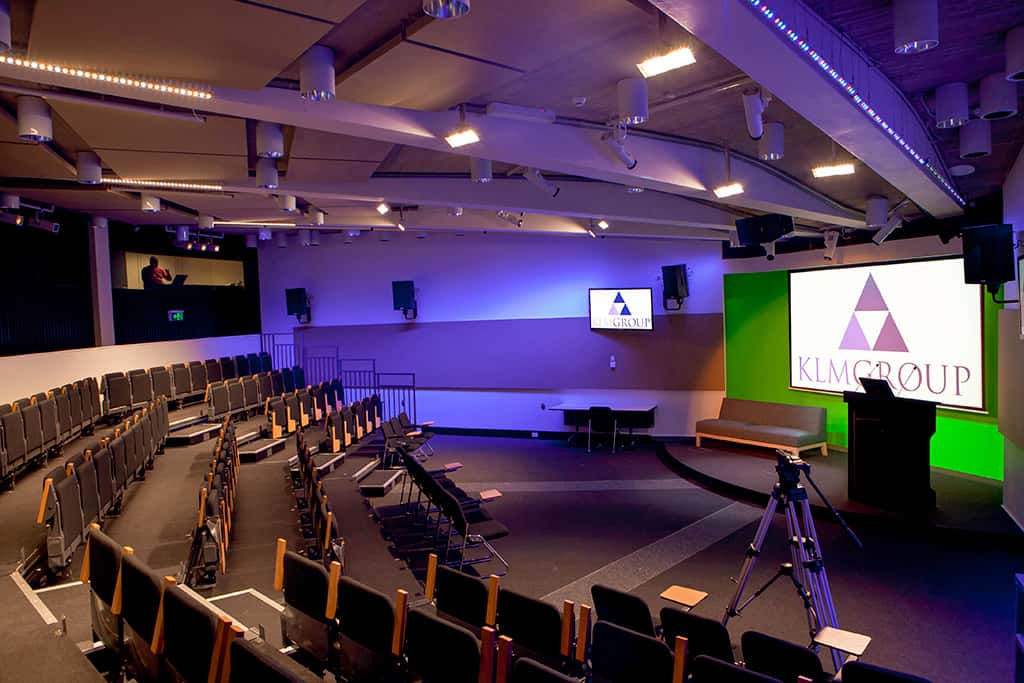
JOB LOT
KLM’s ACT branch successfully tendered for a $600k project in the early stages of the Edmund Barton refurbishment and AFP relocation. This project worked out so well for the clients that KLM was invited to work with design consultants Sinclair Knight Merz in planning and implementing the AV rollout for the remainder of the project. KLM’s total involvement in the refurbishment and relocation eventually grew to about $6m of work. By now a significant project, KLM received the 2010 Crestron Award for Best Commercial Project and featured as a finalist in our own AV Industry Awards (AVIAs) in the ‘AV Projects Over $1m’ section.
A significant part of this project involved the complex logistical task of preparing new infrastructure to receive equipment already owned by the AFP, then dismantling and moving the gear from its previous locations, and finally installing and recommissioning it in the Edmund Barton Building. This aspect of the project was further complicated by various sections of the client’s organisation appropriating other sections’ equipment before it could be installed – a crime wave worthy of reporting o the national police. Fortunately there were accurate records of what belonged to whom, so police intervention was ultimately avoided.
FULL SCOPE
Don’t think for a moment that this project was entirely about shifting and re-installing old gear. Spread across the six levels of the Edmund Barton building are many dozens of meeting rooms, briefing rooms, training rooms and conference rooms equipped with AV gear in different configurations. There are some 27 different types of room configurations, ranging from those equipped only with the infrastructure for later installation of TVs or projectors, to those with just a 26-inch LG LCD TV and on to a wide variety of others kitted out with Panasonic projectors, NEC LCD panels, audio and video conferencing capabilities, LG TVs, TeamBoard interactive whiteboards, Nexia DSP-based echo cancelling, handheld radio mics, computer inputs and of course a slew of Crestron control panels.
The muster room on Level Five is actually a cluster of six rooms separated by operable walls. Each room is equipped with suspended screen and audio replay capabilities, but the rooms can be combined in various groupings with matching audio and video joins. There are three very well-specified (~$120k per room) conferencing facilities (two of them in secure areas). Each includes dual-camera, dual-screen video conferencing, overhead microphones, interactive whiteboards, audio and video replay, and inputs for multiple computers. Audio processing for both audio and video conferencing facilities is Biamp Nexia throughout. Video conferencing at the time of handover was all Tandberg systems, but the entire Attorney General’s department has since moved over to Polycom.
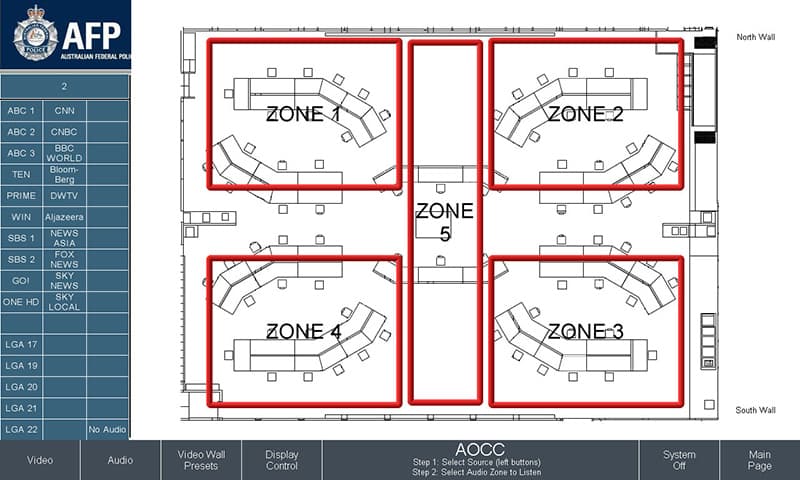

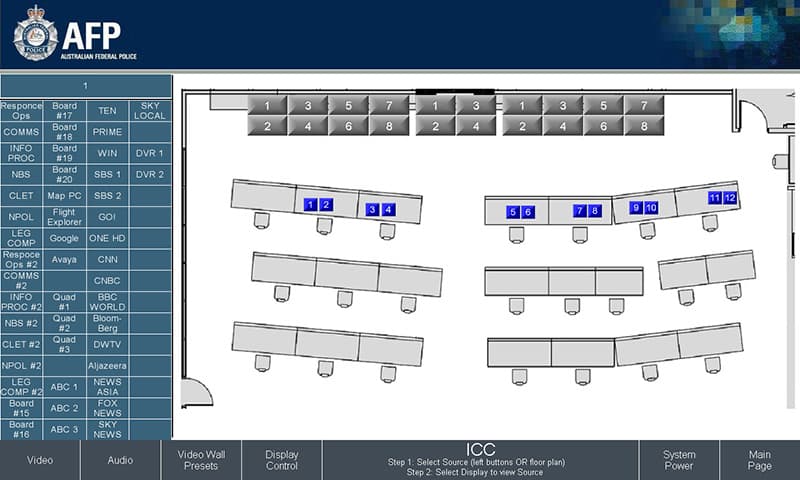
NB: AFP’S AOCC
The most impressive part of the AFP facility is the AOCC (AFP Operations Control Centre) on the lower ground floor which includes the separate ICC (Incident Control Centre) and the SKIFF room for the Attorney General’s department. In addition to 42 video-equipped workstations the main AOCC room features two video walls and the ICC a single wall in addition to its 12 video workstations. All three videowalls are of the same design: 16 NEC 46-inch LCD panels split into two groups of 4×2 panels separated by a projection screen covered by an interactive projector. The image switching and screen processing for each videowall is handled by a Crestron DVPHD high-definition digital video processor. The idea behind this layout is that the signal from any one of the 16 LCD panels can be ‘transferred’ onto the larger image of the projection screen for discussion and annotation then returned to its original LCD panel. Not only does this configuration provide a larger image of the stream under discussion, it avoids the need for building interactivity into every one of the 48 vision streams being displayed on the three walls.
Perhaps the single most impressive piece of AV technology in this facility is the ingestion and distribution system. The initial system called for a Crestron-controlled switching matrix with 108 inputs feeding 118 outputs, a feat made all the more impressive by its timing. As Allan Wade, KLM’s AV project manager for this job put it: “If we had started just six months later on this project, we’d have gone to digital video, possibly over fibre”. Instead the system is built around a six-rack Magenta Mondo matrix frame switching RGBHV video over Cat5 UTP to and from Magenta MultiView Cat5 transmitters and receivers. Inputs to the system consist primarily of off-air feeds from an MATV system together with feeds from an analogue pay-television service and direct feeds from AFP and customs operations at ports and airports. The majority of these sources require a fair bit of cleaning up before insertion into the switch matrix.
With all those screens and their accompanying audio feeds, in an attempt to manage the potential cacophony, the sound for both the AOCC and ICC has been broken down into zones, each with their own source and level selection via the Crestron control system. Each workstation position also has its own local source selection to drive headphones.
THEATRE OF THE SECURE
There is really only one room in the entire Edmund Barton complex that actually welcomes visitors (sometimes), the Media Theatre. With facilities jointly designed by KLM and Videocraft, the theatre is intended for media briefings, press presentations, interviews and video production. The sound in this facility encompasses acoustic treatment, sound reinforcement and audio signal splits for broadcast media and in-house video production. The use of retractable seating allows the space to be used either for presentations and media conferences or as a flat floor production studio. A green screen wall and accompanying LED lighting facilities allow the three-camera production and recording system substantial flexibility as a media briefing venue or as a source of live or recorded material. Crestron digital media is used for both signal switching and routing and for integration into the automated control booth. The two edit suites round out a small, flexible production facility that would seem far more than adequate for the needs of any police force.
READ THIS NOTICE
Due to the highly sensitive nature of the material contained in this article, if you’ve read all the way to the end you now know far too much about our country’s security services to be allowed to live. Under the terms of the Commonwealth Official Secrets Act, you are now required to lick this cyanide-impregnated square so you can’t pass the information on. A heavily armed clean-up squad of black-clad paramilitary operatives should be breaking down your door in about 10 minutes to make sure there are no surviving eye-witnesses.



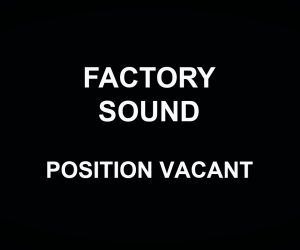
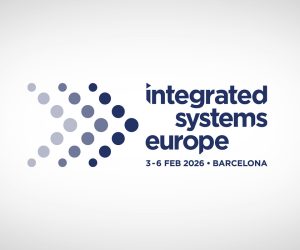







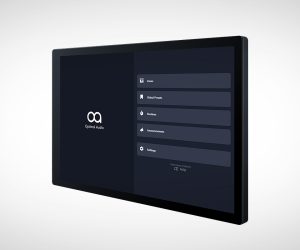


RESPONSES